What Is App Scalability and Why Is It Important?

According to Allied Market Research, the global mobile application market size is expected to reach a staggering $407 billion by 2026. It is a massive growth point, considering the market was worth $106 billion in 2018. With the market rising and many companies seeking app development, several options exist for making the app up-to-date with market trends.
You either hire a software product development company to constantly upgrade your app or design a new software product. Another option is to make a scalable app, one that can be changed and improved at will. App scalability, when used properly, is something that can serve as a game changer. Yet, to tap into the phenomenon, you must consider several key aspects.
Keeping all the insights in mind, let’s explore what app scalability means. In addition, it is important to determine the primary factors affecting application scalability. Furthermore, one should explore the nature of the phenomenon’s importance. Besides, we will show how to improve app scalability in several ways. Finally, there are particular things to consider to secure effective and seamless scalable web application processes.
What is App Scalability?
In general, designing and building an app is an extensive and laborious process. Starting from an idea behind an app toward a final usable product, a long development cycle ensues. In such a case, when your app is up and running, you want your app to provide an excellent user experience. Yet, many companies fail to do that because the app’s user interests and desires change. Besides, if the number of users frows fast, an app might experience great downtime, adversely affecting user experience.
In such a case, to make sure an app does not have too much downtime and the overall infrastructure handles it right, you need scalability. Essentially, app scalability is the product’s ability to keep up with the rising number of users without having an adverse impact on user experience.
So, what is application scalability? It guarantees that your app can sustainably handle the growth of the user base. To have a scalable app, you need it to be properly configured. In technical terms, it is crucial the right hardware and software protocols are properly aligned with one another to face the high number of requests per minute (RPM). To ensure proper app scalability, you need to know the potential factors that can affect the phenomenon.
Factors Affecting App Scalability
In short, there are several dozen factors that can have an effect on app scalability. However, when narrowing down the list, there are seven key aspects to consider:
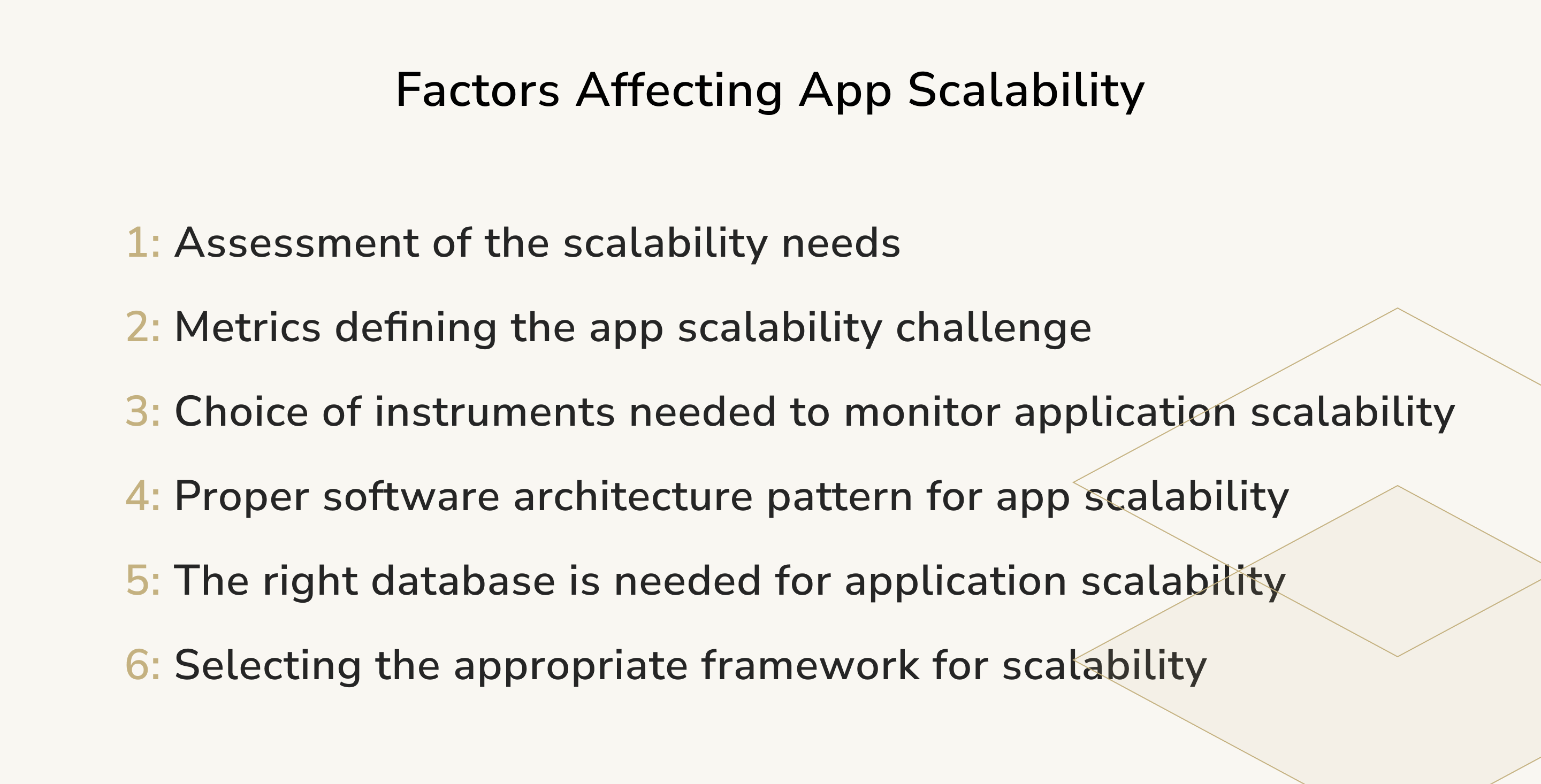
Assessment of the scalability needs
App scalability can be a costly endeavor. At this point, assessing whether you need scalability in the first place is crucial to understand whether the process will justify the expenses. To help you negate this factor, you need to collect data, ensure you need scalability, determine the storage capacity to use for scalability, and determine whether your given infrastructure can handle a rapid increase in user and data traffic.
Metrics defining the app scalability challenge
The next factor potentially affecting app scalability is all about different metrics. At this point, focusing on particular scalability issues is vital. Essentially, you can use four metrics: memory utilization, CPU usage, disk input/output, and network input/output. Improper definition of the app scalability challenges can derail the entire process of scalability from the very beginning.
Choice of instruments needed to monitor application scalability
After deciding the metrics to use for measuring the scalability challenge, it is time to focus on the tools needed to monitor the app scalability process. Choosing the wrong instruments can drastically impact how the application scalability process unfolds. In most cases, you have an array of tools to monitor the phenomenon, from PaaS and IaaS solutions to AWS instruments like Heroku and New Relic. These come with built-in monitoring tools you can use to track app scalability challenges.
Proper software architecture pattern for app scalability
Often coined as one of the most important factors of app scalability, having a proper scalable architecture provides the foundation for the entire process. If there are any architecture issues, this can have a drastic adverse effect on scalability. Often, companies use two architecture patterns most suitable for app scalability.
- First and foremost, monolithic architecture has a built-in broad system and one particular codebase.
- Second, there is microservices architecture, one entailing several built-in small services, each with a separate codebase.
The right database is needed for application scalability
In application scalability, having the right database is often crucial for ensuring the process’s effectiveness. After you addressed aspects like monitoring and architecture, you emphasized databases. There are relational and unstructured databases. Basically, you need to choose between MySQL, PostgreSQL, and NoSQL. This choice has a massive effect on app scalability.
Selecting the appropriate framework for scalability
Finally, it is crucial to understand that a choice of framework can significantly impact app scalability. Depending on the determination of a programming language and the infrastructure, you can see how it will affect the app's performance once it is scaled. In most cases, you will face performance issues if you choose the wrong framework after the app scalability process. Consider frameworks like Django, Ruby on Rails, Node.JS, and Angular JS to avoid that.
As a result, the above factors can significantly impact app scalability. At this point, you need to keep track of tools used to monitor scalability, issues you focus on, the database you use, the infrastructure you employ, and the framework you adopt. After all, understanding the role of the factors above and choosing the right elements based on the insights is vital for application scalability to go smoothly and effectively.
Why is Application Scalability Important?
To understand why companies seek web application scalability, it is important to look at the benefits it brings. In a nutshell, there are three key advantages the phenomenon delivers. Let’s take a look at each one of them in detail.
Increased usage without distinct performance degradation
As it was mentioned above, the very nature of app scalability is directed at ensuring the app have sufficient room to handle the increasing number of users. However, another important thing is to face this challenge without losing performance. There are particular fluctuations in user usage. For instance, during Christmas and Black Friday, the app usage can skyrocket, and if its framework, infrastructure, and database cannot handle that, there will be a major downtime. In such a case, the downtime leads to a worsening of user experience.
In such a case, app scalability handled properly, is a great chance to get a product prepared for an increase in usage without performance degradation. If your app is ready for increased usage and is capable of maintaining great performance, it will ensure a balanced user experience.
Rapid app growth and expansion
Handling more users means you get a chance to expand your business. Necessarily, it means you will work with more users and will meet the needs of numerous clients. Strategic app development focusing on app scalability is perfect for sustaining rapid growth. Respectively, you need to keep in mind that sustaining growth comes with your ability to scale an app development coming, along with quality assurance (QA) and scalability testing.
Notably, when growing and scaling a product, you need to be able to identify glitches and bugs on time. One of the worst things with apps is when users see bugs before those who developed an app. In such a case, app scalability coupled with QA and scalability testing, you can sustain growth and expansion. As a result, the importance of the phenomenon.
Keeping all the abovementioned important aspects of app scalability apparent, the entire phenomenon focuses on four key elements - user influx, downtime, performance, and user experience. Application scalability is crucial because it helps deal with user influx, assist in reducing downtime, and keeps performance at a level to positively affect user experience.
Boost user experience and customer satisfaction
Going further, decreased downtime and greater performance is a direct way to improve user experience and customer satisfaction. Respectively, if you present a successful marketing campaign, there is a high chance your company will experience an influx of user traffic. Yet, it might be challenging to predict when such an influx might happen.
In turn, if your app is scalable, then you don’t need to worry about a user influx at all. Application scalability is important because it prepares your company and the product it offers for any situation that might adversely impact user experience. If you cover all the ground with web application scalability, you can handle the influx without downtime and performance degradation. As a result, it makes your users more satisfied.
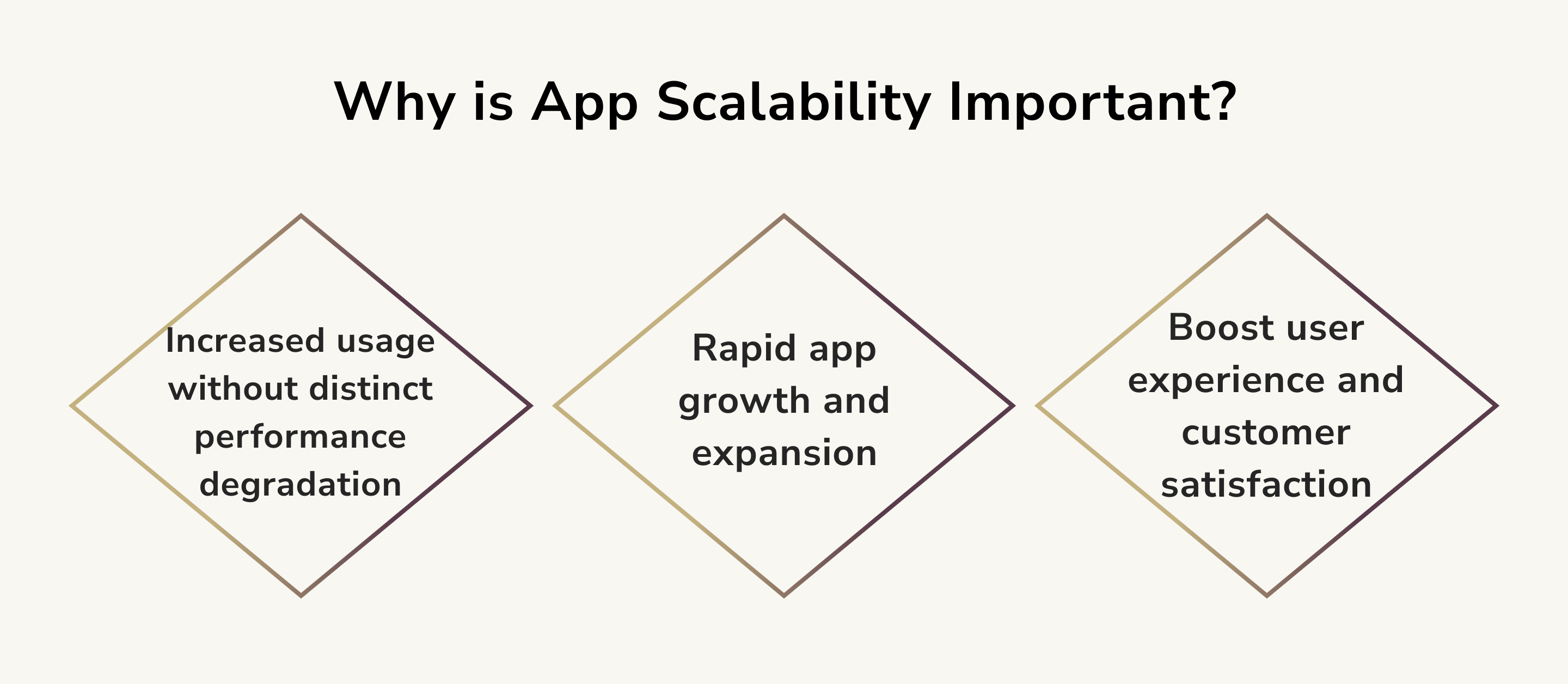
How to Improve App Scalability?
To get the most out of app scalability, it is crucial to know how to improve the process to make it effective. At this point, there are three particular actions you can take to make application scalability to the next level. Let’s explore each one of them in detail.
Designing the product for app scalability from the very beginning
After you get an idea of the app and before you start the development process, it is crucial to answer some important scalability-related questions. Essentially, consider these ones:
- How many users are expected to use an app on average?
- Are there any periods during which user influx is expected?
- Is a flexible data storage option available?
- For how long your server can manage all the users?
- Is the app, your infrastructure, framework, and database prepared to handle more users than expected in the first question?
Answering these simple questions is a direct way to prepare for app scalability in advance. In such a case, you will have solid evidence to understand how scalability can be done effectively and how it can help you maintain exponential growth.
Proper performance monitoring and load testing
The next good practice for improving app scalability is all about using load tests and performance monitoring. In a nutshell, a load test evaluates how your app will hold under high-load conditions. It grants you valuable insights into CPU usage, memory usage, and performance bottlenecks. In such a case, you need to conduct load testing before presenting an app to use app scalability to the best point possible.
In turn, along with load testing, there is performance monitoring. This approach shows the app’s overall performance. In the course of monitoring, you use stress testing. In such a case, the method gives a better understanding of how stable and available the app was. As a result, equipped with load and performance testing, you can get a higher degree of app scalability and ensure it presents what scalability entails in the first place.
Adopting horizontal and vertical scaling along with different technical solutions
Finally, along with designing an app for scalability, using load and performance testing, you can adopt so-called horizontal along with vertical scaling. At this point, these last two aspects are the ones that can help improve application scalability. In such a case, it is important to take a better look at:
- Horizontal scaling. This is also known as scaling out. The process adds more services with the code to increase the overall capacity. Basically, you add new nodes to the infrastructure to get more capacity for handling higher traffic or load.
- Vertical scaling. This is also known as scaling up. The process entails adding more power to your existing machines and servers. It can be adding more processing power to the CPU or more memory.
At this point, with the three instruments above, you can make sure app scalability will be effective. Always design for application scalability even if you don’t see a user influx in the near future. Perform load and performance testing to know what your app is capable of performance-wise and how stable it would be if a user influx appears. Finally, consider horizontal and vertical scaling to help meet the app’s performance needs.
12 Things to Consider During the App Scalability Process
At the moment, we know much about application scalability. There are particular things showing the phenomenon’s importance, as well as particular actions you can take to improve app scalability. Besides, there are also certain things to consider to have a smooth app scalability process. In the list below, there are twelve such elements.
Clean code
To get app scalability to the point you intend, it is crucial to keep code clean at all times. Having proper and productive code is a vital part of scalability. The so-called spaghetti code is often choppy and hard to maintain. Essentially, everything that is hard to maintain will create problems with scaling.
12-factor-rule
The 12-factor-rule is a great methodology focused on the top development practices related to application scalability. In a nutshell, the approach emphasizes 12 factors that directly link developers and scalability. Following the 12-factor rule is excellent for making scalability flexible, which means you can easily implement it.
Database
Another thing you can do to take care of app scalability is all about taking care of databases. With a proper database on board, you can create conditions in which scalability will be achieved smoothly and without any hiccups. Yet, when selecting the database, keep in mind that you also need to design a robust schema. It will serve as a tool for managing the rising number of transactions per second.
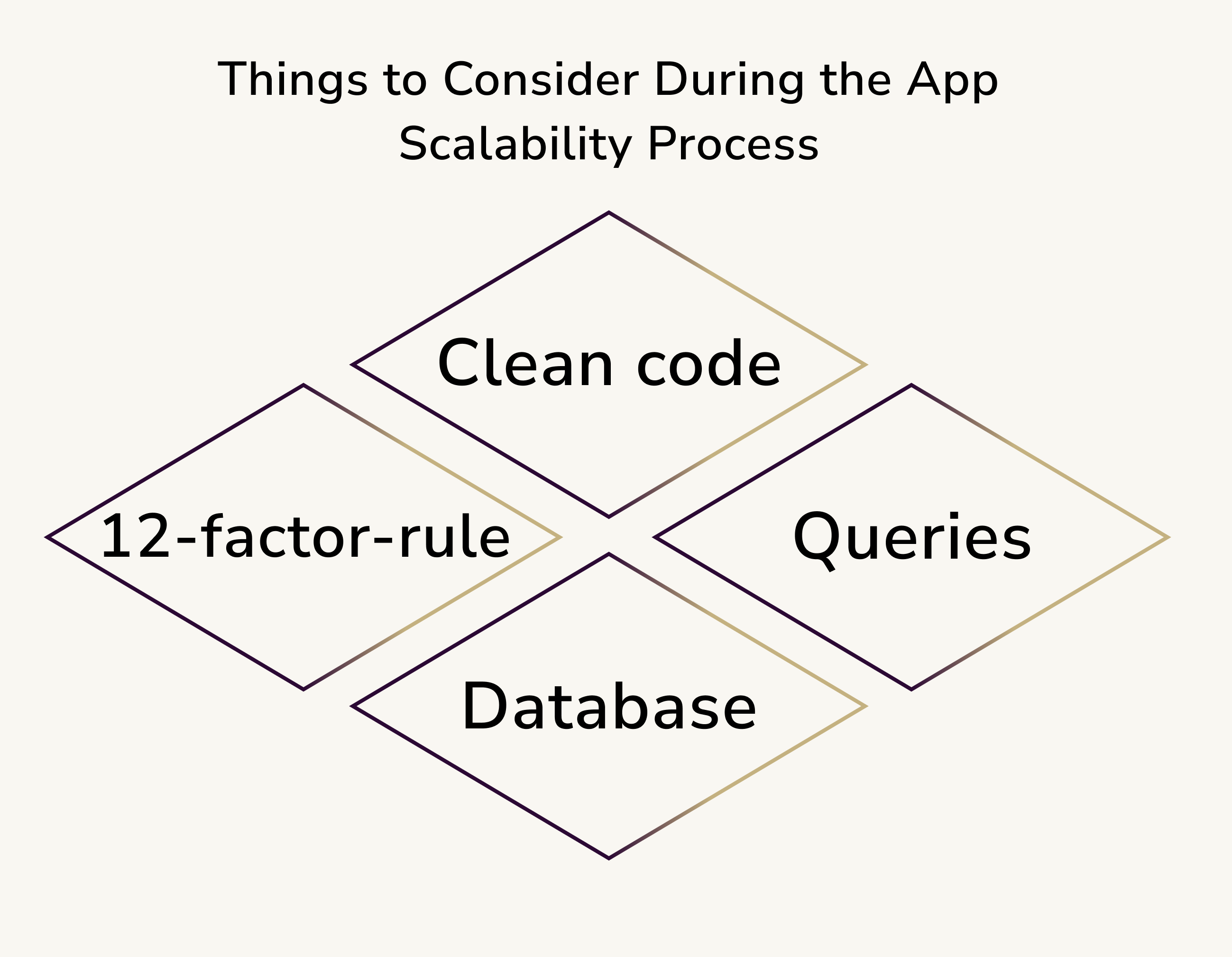
Queries
In addition to the aspects above, you need to prevent all the potential issues with queries. In reality, every app there operates with multiple database queries. However, even if you have top-notch relationships with all the proper indexing and runs on the best-performing machines, there can still be challenges with queries. That is why double-check the queries to avoid N+1 cases and unnecessary eager loading. It will save you a lot of time and nerve during app scalability.
Proper hosting
The next thing to do is to choose the right hosting. People often think that application scalability revolves mainly around code. In reality, smooth app scalability is also about the right server infrastructure and correct configuration. At this point, you need to choose the right hosting tool. Often, it is narrowed down to Amazon EC2 and Docker.
Caching
Often, it is a good practice to implement, modify, and track all the caching needs your entire system might need. However, it does not mean you need a dedicated machine to take care of all the caching involved. Otherwise, improperly handled caching can overload the database and create solid issues for the entire app scalability process.
Load balancing
To ensure smooth application scalability, you need to take care of load balancing and reverse proxying. In short, it means you need to prepare yourself that one day there will be a switch from a single-server to multi-server architecture. At this point, to prepare for load balancing, it is set to use some of the ready-to-do infrastructures. In most cases, users prefer AWS to do that.
The backend
The next aspect is about relieving the backend to take pressure from the servers handling the application scalability. If you have an opportunity to transfer some portion of the code to the front end, it is best to do it. In such a case, taking the load of the backend is a direct way to make it less overloaded. Respectively, it means on the client side more things can be done and computed.
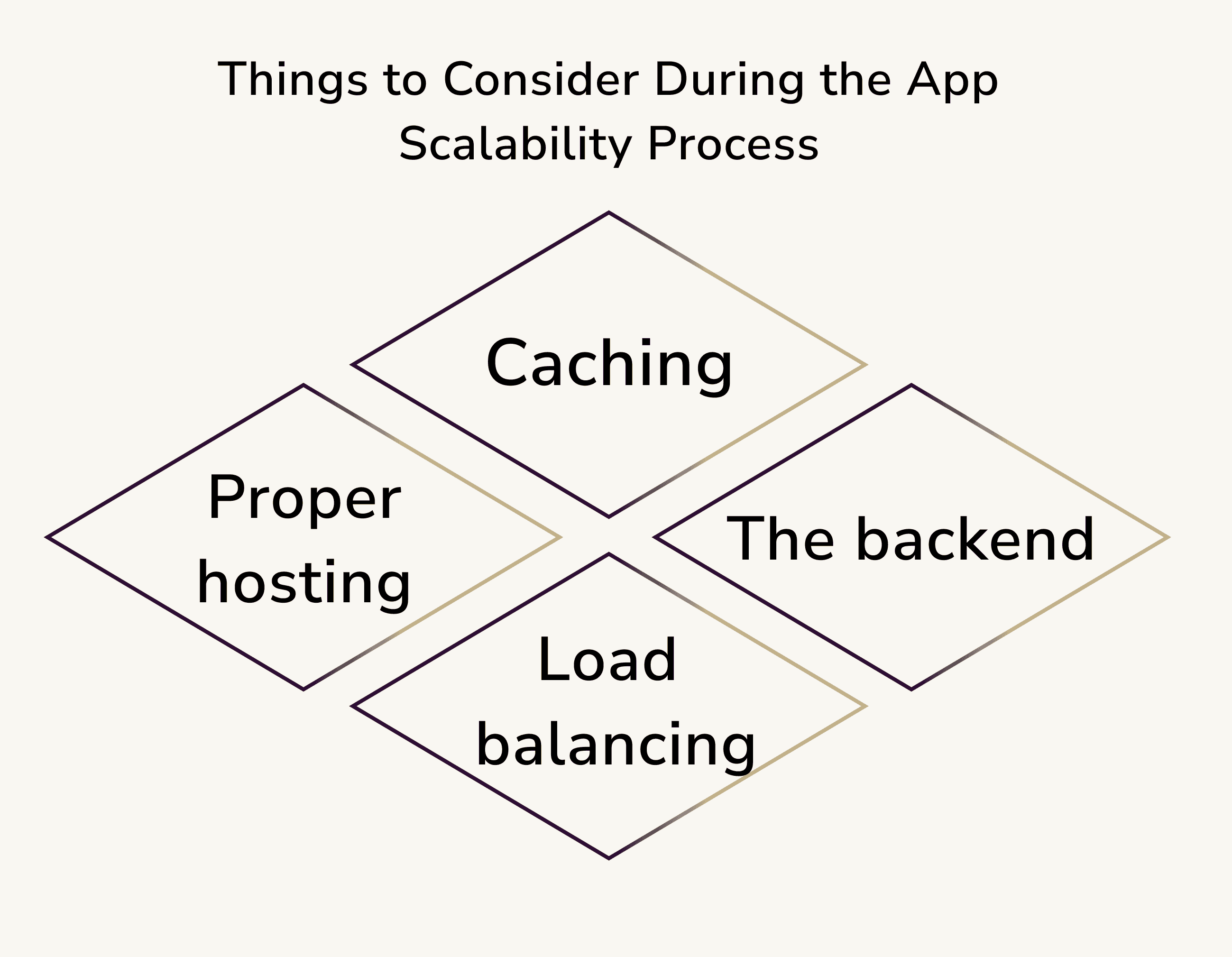
Testing and monitoring
Even if you managed to write a clean code, it still should be tested and monitored. In most cases, each test iteration might find some issue that will later turn into a major problem with app scalability. In short, the rule of thumb dictates testing and monitoring is a great way to deal with issues in advance. It is better to test the app one more time than later deal with major challenges faced during the scalability process.
Optimization
Testing and monitoring allow you to identify the issues. However, finding the problem is one thing. However, it is crucial to get the tools that will optimize your code and entire configuration. In such a case, optimization will minimize the number of bottlenecks your app scalability process will experience. In most cases, optimization is the best way to have a system that prevents an issue from appearing in the first place.
Code separation
One of the things you can do with code after cleaning it is to separate code. It entails not mixing various parts of the system in one particular place. In such a case, it means you can separate various frontend and backend layers, as well as separate different background jobs from the main system. Besides, you need to use all the patterns properly. These separation processes make app scalability smooth.
Regular updates
Finally, the last but not least thing you can do to ensure application scalability is all about adopting regular updates. Keep all the stuff inside the system up-to-date. In general, all outdated elements will thwart your system and make app scalability slow and painful.
All the 12 elements above help make app scalability as effective and smooth as it can be. However, it does not mean you should use all of them. Even if you manage to apply several elements from the list, there is a high chance you will get a good scalability process underway.
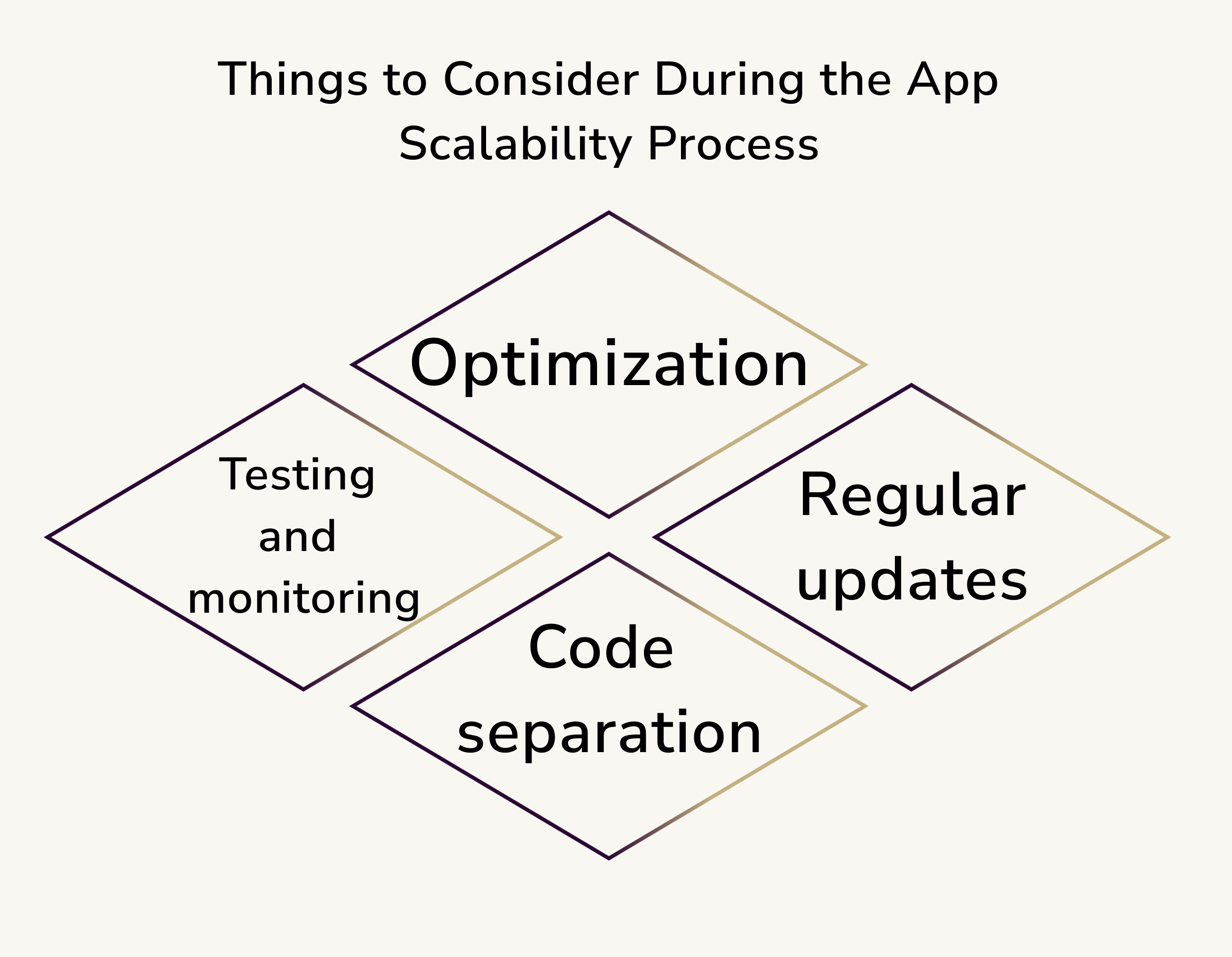
Conclusion
App scalability is the process of preparing your software product for the occasions when the user influx happens. It is crucial for avoiding downtime and losing performance. After all, owning an app means you want to provide the best user experience possible. As we have shown above, application scalability is important. There are certain things you can do to improve app scalability. Finally, you can follow the list of 12 things from previously to make app scalability smooth and effective.
If you have more questions about scalability or mobile app development, do not hesitate and contact us!

Andriy Lekh
Other articles